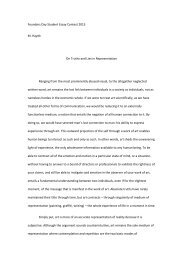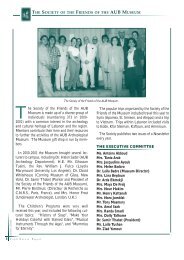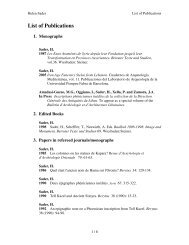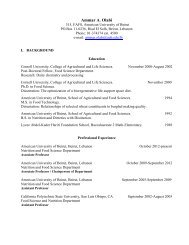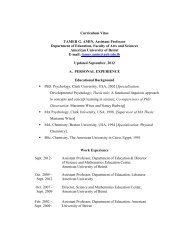The IX t h Makassed Medical Congress - American University of Beirut
The IX t h Makassed Medical Congress - American University of Beirut
The IX t h Makassed Medical Congress - American University of Beirut
Create successful ePaper yourself
Turn your PDF publications into a flip-book with our unique Google optimized e-Paper software.
T h e I X t h M a k a s e d M e d i c a l C o n g r e s s<br />
LONG-TERM IMPACT OF PERINATAL ENVIROMENT<br />
Laurent Storme MD<br />
<strong>The</strong> main causes <strong>of</strong> morbidity and mortality have perinatal environmental origins. Early intrauterine<br />
and postnatal development is a unique period <strong>of</strong> vulnerability during which adverse<br />
environmental stressors, disruptors and insults, may have lifelong impact on health. Perinatal<br />
programming may permanently modify disease susceptibility. We now know that such insults,<br />
even transient, program lifelong alterations in homeostatic regulations which lead to the<br />
commonest diseases encountered in adulthood, including diabetes, hypertension, infarcts,<br />
stroke, and cancer.<br />
<strong>The</strong> current hypothesis proposes that fetal adaptations to intrauterine and maternal conditions<br />
during development is able to impair structure and function <strong>of</strong> organs. Perinatal programming<br />
may cause permanent changes in vital organs, altered cell number, imbalance in distribution <strong>of</strong><br />
different cell types, and altered blood supply or receptor numbers.<br />
<strong>The</strong> mechanisms underlying the early programming <strong>of</strong> diseases later in life is presently uncertain.<br />
However, experimental data and clinical studies suggest that epigenetic changes in regulatory<br />
genes and growth-related genes play a significant role in the perinatal programming.<br />
Improvements in our understanding <strong>of</strong> the mechanisms would trigger the development <strong>of</strong><br />
preventive and therapeutic strategies. <strong>The</strong>re is an urgent need for a better understanding <strong>of</strong><br />
what might well be a threat to the sustainable development <strong>of</strong> human individuals.<br />
PERINATAL HEALTH IN MIDDLE EAST AND NORTH AFRICA AREA<br />
Robert Sacy MD, R. Kamel, I. Dabaj<br />
We will study main issues <strong>of</strong> perinatal health in MENA area which includes countries <strong>of</strong> Middle<br />
East and North Africa. Governments in region are trying their best to achieve equity among<br />
citizens and to respect human rights keeping the cultural values at primary importance. “Good<br />
Health is a basic human right” [12] and a must for a socioeconomic development. Women play<br />
a major role in raising children and family, thus, she has important role in society. In MENA area,<br />
despite all accomplishments in past years, there were lots <strong>of</strong> reproductive issues and major<br />
threats on women’s health which lead to threats on children’s health. <strong>The</strong>re is a link between 3<br />
important issues: health, social development and size <strong>of</strong> gaps between genders and different<br />
socioeconomic status. War was one <strong>of</strong> the major factors affecting all the 3 issues..<br />
Maternal and neonatal death; war; consanguinity, early marriage; sexually transmitted diseases;<br />
violence will be reviewed. Data were collected from review studies. A large part <strong>of</strong> our information<br />
was taken from W.H.O, Ministry <strong>of</strong> Health in different Arabic countries and many reports from<br />
United Nations, USAID, UNDP, and UNICEF.<br />
Mortality<br />
Maternal mortality: Health <strong>of</strong> newborn is linked to safety <strong>of</strong> mother. Children before age 10 whom<br />
mothers died are 3 to 10 times more likely to die 2 years earlier than children with living parents.<br />
Maternal mortality in MENA region remains high with 18000 deaths. Mortality in Yemen is one <strong>of</strong><br />
the highest in the world [10]. After Gulf war, mortality in Iraq increased rapidly. [11] Major causes <strong>of</strong><br />
death are bleeding, infections and eclampsia [23]. (Fig.1)<br />
Neonatal death and still birth: low birth weight is a debatable cause <strong>of</strong> death [13]. Stillbirths account<br />
44






